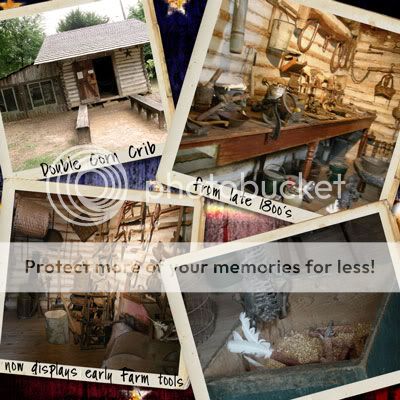A Great Day Trip
A couple of weeks ago, my neighbor called me up to see if the kids and I wanted to go to the Fort Bend County Museum and the Morton Cemetery in Richmond, Texas. After about half a second of thinking, I replied, "Yes!" [How cool of a Cajun neighbor do I have?] We all had a great time touring historic homes that contained many beautiful antiques. The little museum was a pleasant surprise in this sleepy town. From the outside you'd never imagine what is packed inside of it. Between the museum, the historic homes, and the Morton Cemetery, I took a ton of pictures [and we didn't even tour all of the homes in Richmond]. Some pictures are of official registered landmarks and some tell an important part of our Texas history. There are so many to share that I've broken them down into more "easily-digested" pieces. Plus, I'll share the tombstone and cemetery pictures on my companion blog, "Family Stories in Stone." [I've already shared some here.]


View Larger Map



View Larger Map
Sources:
Texas Historical Commission's Texas Online Handbook
Fort Bend Museum Association
A couple of weeks ago, my neighbor called me up to see if the kids and I wanted to go to the Fort Bend County Museum and the Morton Cemetery in Richmond, Texas. After about half a second of thinking, I replied, "Yes!" [How cool of a Cajun neighbor do I have?] We all had a great time touring historic homes that contained many beautiful antiques. The little museum was a pleasant surprise in this sleepy town. From the outside you'd never imagine what is packed inside of it. Between the museum, the historic homes, and the Morton Cemetery, I took a ton of pictures [and we didn't even tour all of the homes in Richmond]. Some pictures are of official registered landmarks and some tell an important part of our Texas history. There are so many to share that I've broken them down into more "easily-digested" pieces. Plus, I'll share the tombstone and cemetery pictures on my companion blog, "Family Stories in Stone." [I've already shared some here.]


The Museum & The "Old 300"
As I mentioned before, the museum was a pleasant surprise. It may be small, but it packs a big "punch" as far as Texas history is concerned. It starts off with an exhibit of Stephen F. Austin [a.k.a. Father of Texas], and his "Old 300." I've mentioned him before on a previous post. He followed his father to Texas, where his dad procured a Spanish land grant, but then shortly thereafter, he died. After a few "hiccups" [mainly Mexico winning its inependence from Spain in 1821] Stephen F. Austin finished the job, and the rest, as they say, is Texas history. According to the Handbook of Texas Online and the museum exhibit, Austin [now an "empresario" a.k.a. an immigration promoter] divvied up the land grant then actively recruited his first group of colonists from the United States from about 1822-1824. A lesser known fact is that there were actually 297 grantees not 300, not counting Austin's own grant. [I guess I'm not the only one who likes "round" numbers. The "Old 297" just doesn't have the same ring to it either...] The grants were family grants, so in order for Austin to allow single men into the colony, they had to be issued to partnerships of two men [who would further divide up the land between them]. Also, there were 9 families that received 2 land grants. The only stipulation was that the grantees had to have the land improved within 2 years of grant issuance, and most were able to comply [only 7 grants were forfeited]. Each farming family received one "labor" [or abt. 177 acres], and each ranching family received one "sitio" [or abt. 4428 acres]. [If I had been those colonists, I would've said I was a rancher...] Actually, according to the Handbook of Texas Online, some did do this, even though they had never ranched before. Hey, it came with waterfront property on the Brazos River "equal to about one-fourth" of the land grant's length. For those who have no clue about ranches and ranching [not that I have first-hand knowledge; we're not all ranchers here...], a water source is imperative for your operation to keep the cattle watered and the grass green for grazing. Basically, no water leads to no cattle, which leads to no money, which leads to no food, etc. Not only did these first colonists settle on the Brazos River, but the banks of the Colorado and the San Bernard Rivers were occupied - from the areas that are now known as Brenham, Navasota, and La Grange down to the Gulf Mexico. [Below is an overview map of the general area of Fort Bend County and surrounding counties. Richmond, Texas is marked.]
View Larger Map
Where Were the Colonists From?
Austin was a planner, and I say that because he didn't just open up his colony and let anyone into his colony. He was careful to think about who he wanted to invite. According to the Handbook of Texas Online, he wanted no problematic issues with his colonists, so he recruited those mainly from a good class who were from what is known as the Trans-Appalachian South - mainly Louisiana, Alabama, Arkansas, Tennessee, and Missouri. [Drunks, gamblers, and/or ne'er-do-wells need not apply.]

How Did the Colonists Get To Texas?
Pictured above is a diagram of the migrations of the "Old 300" to Texas. Some came by land, and some came by sea [or, rather, by the Gulf Of Mexico]. No matter which way they came, it was a rough ride, and when they got here, they found a very unforgiving land [as the first German immigrants would find out approximately 20 years later]. Also, pictured here is a diorama of what the colonists would've brought with them when coming via the Gulf of Mexico.
Pictured above is a diagram of the migrations of the "Old 300" to Texas. Some came by land, and some came by sea [or, rather, by the Gulf Of Mexico]. No matter which way they came, it was a rough ride, and when they got here, they found a very unforgiving land [as the first German immigrants would find out approximately 20 years later]. Also, pictured here is a diorama of what the colonists would've brought with them when coming via the Gulf of Mexico.

So What Does This Have To Do With Richmond, Texas?
A good question because if you'll notice, I haven't really mentioned Richmond in this whole explanation of the first colonists of Texas. If you take a close look at the map pictured below, you'll see that Richmond, Texas is on the Brazos River. It is located in and is the county seat of Fort Bend County, but neither was formed and/or incorporated until 1836 [when Texas won her independence from Mexico, and the Republic of Texas was formed]. However, in the area that would become Fort Bend County, 56 families of the "Old 300" settled. In fact the "Fort" in Fort Bend comes from the term "Fort Settlement" which was the name of the the first 2-room cabin built in the area. The word "Bend" comes from the bend in the Brazos River that occurs in the county, which is shown in the map below. [Not really all that creative, but, hey, it stuck...] Also, the museum had an exhibit on the life on the Texas frontier pictured below. Notice how the logs are squared-off. This was essential because of the humidity. If left round, the moisture would collect in between the logs.

View Larger Map
So Were These Colonists Still American?
Uh, no. When Austin and his father came to what is now known as Texas, Spain was running the show. Then in 1821, Mexico, tired of being ruled by a monarchy that was too far away to understand its day-to-day problems [a common theme in history, I might add], fought and won its independence from Spain. Of course, Mexico's problems with Spain would later mirror the problems that Tejas would have with Mexico's government [but I'm getting ahead of myself and all that's for a later post...]. Now, back to our first colonists: it was part of the land grant deal that they become naturalized citizens of Mexico. I'd imagine with the wide-open spaces, the sizes of & cheap prices of the land grants combined with the long distance of the Mexican government all helped to make becoming a Mexican citizen not that big of a deal. However, that long distance from their government would later become a seed of resentment that would help to grow problems that led to an all-out bloody fight for independence. [More on that later...]
Uh, no. When Austin and his father came to what is now known as Texas, Spain was running the show. Then in 1821, Mexico, tired of being ruled by a monarchy that was too far away to understand its day-to-day problems [a common theme in history, I might add], fought and won its independence from Spain. Of course, Mexico's problems with Spain would later mirror the problems that Tejas would have with Mexico's government [but I'm getting ahead of myself and all that's for a later post...]. Now, back to our first colonists: it was part of the land grant deal that they become naturalized citizens of Mexico. I'd imagine with the wide-open spaces, the sizes of & cheap prices of the land grants combined with the long distance of the Mexican government all helped to make becoming a Mexican citizen not that big of a deal. However, that long distance from their government would later become a seed of resentment that would help to grow problems that led to an all-out bloody fight for independence. [More on that later...]
Next post: The story of a woman who would later be known as "The Mother of Texas."
Caroline
Sources:
Texas Historical Commission's Texas Online Handbook
Fort Bend Museum Association

























